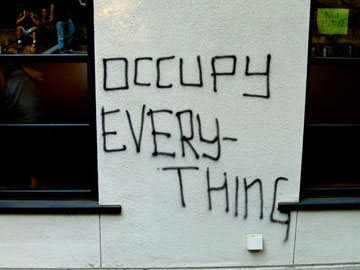To explain the recent investigations into the web-art projects of both Ricardo Dominguez and b.a.n.g. lab collaborators at UC San Diego and Ken Ehrlich of UC Riverside is to tell a story of social movements. This is the first of a several blog-posts written by myself and Art21 Los Angeles correspondent Catherine Wagley that tell the story. In this post, I will summarize the basic facts around what happened and provide the simplest of backgrounds to the case.
With the announcement of a 32 percent tuition increase, the antagonism between the UC systems directing regents and many of their students, faculty, and staff was on the rise. Spurred on by a powerful manifesto and an inspiringly radical movement of campus building occupations that began in Northern California in September and only continued to build, March 4, 2010 was planned to be a major day of protests around education throughout California. March 4 proved that the movement was spreading well into what had been the relatively quiet UC campuses of Southern California. The radical edge of the movement has been built upon a variety of very evocative slogans, including We Have Decided Not to Die, We Are the Crisis, and No Future.
….
On the morning of the fourth, Ricardo Dominguez, formerly of the Critical Art Ensemble and now with the Electronic Disturbance Theatre, set up and publicized a virtual sit-in, an Electronic Civil Disturbance (ECD) attack on the UC Office of the President website from the UC-sponsored b.a.n.g. lab server. The theatre piece, set up as contemporary protest, allowed people to act in solidarity with the day’s protesters by loading up a constantly updating webpage. With enough participants in the online protest, the act can slow down or, if you will, blockade a website.
The UC system responded by shutting off the b.a.n.g. lab server and initiating an ongoing investigation against Ricardo. This protest technique, which is legal, is cited as among the reasons why Ricardo received tenure. To quote Paul Drake, the UC San Diego administrator who initiated the investigation, in a comment previous to all this:
“Professor Dominguez’s work, first with Critical Art Ensemble and then with Electronic Disturbance Theater, has been highly cited, and he has been invited to lecture on the work across a host of important international venues… The esteemed status of Professor Dominguez’s field-defining work has been duly noted by the external referees, who include major international intellectuals working in performance art, new media and globalization.”
….
Two days prior, a message was sent out by UC Riverside adjunct faculty Ken Ehrlich. The message was picked up by several news sites pointed to a website, markyudof.com, claiming that Mark Yudof, President of the University of California, had resigned in order that he could “go back to school to study the history of social movements.” The website was hosted on b.a.n.g. lab’s server. Though clearly a hoax to anyone who spent a second looking at the site, Yudof felt compelled to respond. Several weeks later, UC Riverside also felt compelled to open an investigation into Ehrlich. Like the case with Ricardo Dominguez, Ehrlich’s actions were entirely legal. Those familiar with political artwork will have no problem remembering any one of several high profile pranks pulled off by The Yes Men.
…..
The next post will focus on the climate in which these two actions emerged, on activist movements, and the general state of affairs in higher education today.
Note of disclaimer: I am proud to say that I participated in the events about which I am writing.
Marc Herbst is an artist, activist, and the editor of the Journal of Aesthetics and Protest.




Pingback: (UC Crisis) Post 2: The Feeling of Embalming Education | Art21 Blog
Pingback: This blog post costs $2.75 | all these birds with teeth: this is not about science.